|
Andean Cosmology
©1998 by James Q. Jacobs
Ethnohistorical records have provided information about
Andean cosmogonic beliefs at the time of European contact. These records
reflect the pervasive ethnocentrism of the invading conquerors. They
also provide the only written record available. What can be inferred
today depends on scant and biased evidence. It is important to keep
in mind that Spanish chroniclers were writing during inquisitional times
when heretics were put to death. Even writers such as Garcilaso de la
Vega, the illegitimate son of a Spanish conqueror and an Incan prince,
although half-Incan, was reared a Catholic, became a minor cleric and
wrote for an audience in Spain. In this article the word religion is
used in its broadest sense, encompassing cosmogonic beliefs, world view,
and practices and ceremonies reflective of these.
THE PREHISTORIC TRADITION
 Inca religion combined features of animism and a respect
for nature. The Sun, Moon, the cosmos, human progenitors, the highest
mountains and such phenomena as lightning and thunder were venerated.
The Inca pantheon was headed by Viracocha (the creator and a culture
hero), Inti (the Sun), and Pacha Mama (the Earth Mother). Inca religion combined features of animism and a respect
for nature. The Sun, Moon, the cosmos, human progenitors, the highest
mountains and such phenomena as lightning and thunder were venerated.
The Inca pantheon was headed by Viracocha (the creator and a culture
hero), Inti (the Sun), and Pacha Mama (the Earth Mother).
Viracocha was the creator of the Incas, the Sun, Mother
Earth and all else. Viracocha
was called señor del universo, señor del principio, señor
de la primera causa, señor del fundamento, señor del origin,
supreme founder, and Creator of all parts. Viracocha was also the creator
of the Tiwanaku civilization, of which the Incas were cultural heirs.
According to myth he was believed to have created the sun and moon on
Lake Titicaca. After forming the celestial realm and the earth, Viracocha
wandered the earth teaching people the arts of civilization. He was
sometimes represented carrying a staff. It is likely that Viracocha
is the figure sculptured on the Portal
of the Sun at the megalithic ruins of Tiwanaku
near Lake Titicaca in Bolivia.
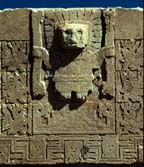 
Viracocha
was the protector of Inca Pachacuti. He appeared to Pachacuti in a dream
when Cuzco was under sieged by the Chanca tribe. Pachacuti defeated
the Chanca, ascended to the position of Inca, and built the monument
to Viracocha in Cuzco.
Inti, the Sun, was believed to be the ancestor of the
Incas. Inti was usually represented in human form, his face portrayed
as a gold disk from which rays and flames extended. Inti's sister and
consort was the moon, Mama-Kilya, portrayed as a silver disk with human
features. Inti was the most important member of the Inca pantheon. The
Sun's powerful energy warms the earth, is vital to life and produces
crops; and, as such, was of primary importance to the agrarian civilization.
Inti was at the head of the state religion, and his veneration was proscribed
throughout the Inca empire. The Incas viewed themselves as descendants
of the Sun. The common people believed the Inca was in communication
with Inti.
The belief in Pacha Mama encompasses the view that the
Earth is a living being. The earth is also considered the mother of
all earthly life, an outlook plausible from an empirical viewpoint and
from a supernatural perspective. Pacha Mama (pacha means earth, mama
means mother) is the personification of fertility and growth as well
as the representation of the female aspect of the Earth, the mother
of all life. The season of growth, the November to April rainy season,
is associated with Pacha Mama. The dry season is associated with Pacha
Tata (tata = father).
According to modern historian-author John Hemming,
"At the time of the Conquest, religion had
been all-pervading in the Inca empire, but it flourished at different
levels. At the top was the official religion, closely identified with
the Inca himself. There was the worship of the sun, moon stars, thunder;
of the creator god Viracocha; of the Inca as son of the sun; of the
mummies and effigies of his royal ancestors, and the holy hills and
caves of the Inca creation legends." (Hemming 307)
The Incas maintained a cast gold man-sized effigy
called Punchao (meaning day, image of the sun). It was described by Viceroy
Toledo as having "a heart of dough in a golden chalice inside the body
of the idol, this dough being of a powder made from the hearts of dead
Incas." (Hemming 318) This most important image of Inti was captured with
Tupac Amaru and probably melted for its gold by Viceroy Toledo.
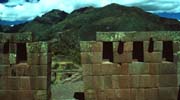 Diego
Rodriguez de Figuero, first embassy of the Spanish in Vilcabamba, wrote
a explicit report of his travel. He reported about solar veneration
by Inca Titu Cusi and his captains. He noted diplomatic proceedings
being interrupted for religious observances. Upon the ratification of
the treaty of Acobamba, which ended the hostilities between the Spaniards
and Vilcabamba for a short period, Titu Cusi is reported to have sworn
facing the sun with upheld arms while incanting, "I swear to thee, O
Sun, who art creator of all things and whom I hold to be God and worship;
and by thee Earth, whom I regard as mother from whom is produced all sustenance
for the support of man" (Temple in Hemming 319). Diego
Rodriguez de Figuero, first embassy of the Spanish in Vilcabamba, wrote
a explicit report of his travel. He reported about solar veneration
by Inca Titu Cusi and his captains. He noted diplomatic proceedings
being interrupted for religious observances. Upon the ratification of
the treaty of Acobamba, which ended the hostilities between the Spaniards
and Vilcabamba for a short period, Titu Cusi is reported to have sworn
facing the sun with upheld arms while incanting, "I swear to thee, O
Sun, who art creator of all things and whom I hold to be God and worship;
and by thee Earth, whom I regard as mother from whom is produced all sustenance
for the support of man" (Temple in Hemming 319).
ANCESTOR VENERATION
Ancestor veneration was a fundamental practice of Andean
society. It was believed the deceased were active in maintaining the
well-being of the living. Forbearers defined societal organization,
with ayllus (kinship groups descended from a common ancestor) named
for their founders.
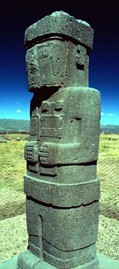 Veneration
extended to the ancestor or ancestors of a group, and to ancestral places
of origin. Ancestor reverence included preservation of the deceased
in mummified and other forms, such as the keeping of skulls of progenitors.
The mummy might be richly clothed, brought out for major festivals and
even attended at special facilities. Inca mummies were even included
in important meetings. The ancestor mummies and images of mythical ancestors
participated in ceremonies. Ciezo de León wrote that each Inca
mummy had its own service set in gold and silver. At certain festivals,
and particularly at a funeral for an Inca, the mummies of all the Inca's
predecessors were brought out into the plaza in Cuzco and the eulogies
of the lineage were chanted. These mythical ballads were relied upon
by ethnohistorical writers and provide in part what we know today of
the history of the Incas as they viewed it upon contact. Veneration
extended to the ancestor or ancestors of a group, and to ancestral places
of origin. Ancestor reverence included preservation of the deceased
in mummified and other forms, such as the keeping of skulls of progenitors.
The mummy might be richly clothed, brought out for major festivals and
even attended at special facilities. Inca mummies were even included
in important meetings. The ancestor mummies and images of mythical ancestors
participated in ceremonies. Ciezo de León wrote that each Inca
mummy had its own service set in gold and silver. At certain festivals,
and particularly at a funeral for an Inca, the mummies of all the Inca's
predecessors were brought out into the plaza in Cuzco and the eulogies
of the lineage were chanted. These mythical ballads were relied upon
by ethnohistorical writers and provide in part what we know today of
the history of the Incas as they viewed it upon contact.
The bodily remains were called 'ylla,' meaning 'cuerpo
de el que fue bueno en la vida' (body of one who was good in life),
and 'yllapa,' meaning 'trueno o relánpage' (thunder or lightning).
Guamán Poma de Ayala wrote that the Inca, upon dying, was transformed
into 'illapa' (thunder). He also reported that the mummies participated
in various ceremonies together with images of mythical ancestors. The
solstical ceremonies were particularly dedicated to the mythical ancestors
and remembrance of origins. Inti Raimi, the festival of winter solstice
and the beginning of the year commemorated the myth of the appearance
of the ancestors, of creation. The festival actualized the myth of origin
and supported the perpetuation of the ancestral order.
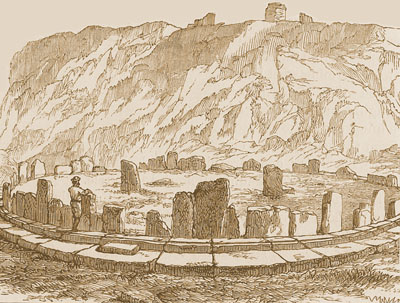
HUACAS AND CEQUES
Hemming reports that during the Inca empire the huacas
around Cuzco were arranged in lines called ceques. The Sun Temple in
Cuzco, the Coricancha, was the sighting point for this system of irradiating
lines to distant horizon features and mountains.
 Along
these forty-one ceques, extended to the horizon and beyond, were located
328 survey points or huacas. This number equals the number of days in
12 lunar orbits. Along
these forty-one ceques, extended to the horizon and beyond, were located
328 survey points or huacas. This number equals the number of days in
12 lunar orbits.
Huacas are a general category of sites such as mountains,
rocks, hills, springs, caves, made-made pyramids, pillars, towers, and
other monuments, places of origin, burial places, caves of ancestors,
cairns of stones and other special places in the landscape. One such
monument is the Yurac-rumi (white stone) in the Vilcabamba valley, discovered
by Hiram Bingham, discoverer of Machu Picchu.
The 25 by 52 feet white granite outcrop is covered with
complex carvings, including rectangular seats, projecting stone squares,
a cave with niches, a flattened top and platforms. Another class of
carved bedrock stones are the Intihuatanis, the 'Hitching Posts of the
Sun.' Intihuatanis were considered to be of importance, as inferred by
the fact that those found were destroyed by the Spaniards. Symbolic
offerings were left at huacas. At stone piles on mountain passes the
passerby would add a stone to the cairn.

The Intihuatani at Machu Picchu. Machu Picchu
and the Inca Trail Placemarks.
INCAN RELIGIOUS INSTITUTIONS
Under the Inca empire there was a highly organized state
religion. The official priesthood maintained temples and convents in
the main cities. Priests resided at important shrines and temples. Near
South America's highest peak, Mount Aconcagua in Argentina, near the
southern extreme of the Inca realm, an ancient monument of high regard
was maintained. On Titicaca Island in Lake Titicaca a House of the Sun
and a House of the Moon were maintained. These two may have symbolized
the creation of the Sun and the Moon by Viracocha, an event mythically
linked to the lake, or may have been linked to ancestors of the Incas.
The most important Monument of the Incas was the Coricancha
(Golden Enclosure) in Cuzco, wherein there was a room with models of
plants, animals, birds, and even the clumps of earth, all of gold. The
Coricancha House of the Sun was used by the royal family in important
ceremonies such as winter solstice. A drawing of Incan cosmogony on
the main altar of the Coricancha was created by the Indian chronicler
Juan Santa Cruz Pachacuti Yanqui Salccamaygua. Roberto Lehmann-Nitsche
wrote of the altar, "in its images they concentrated the most important
manifestations of religious concepts from a specific period and a population
that reached the highest development of aboriginal South American civilization."
(Valencia, 90, my translation)
In Juan Santa Cruz's drawing in the top center a large
oval form symbolizing Viracocha is flanked by the sun and the moon.
Below the sun the earth is drawn, with Venus as Morning Star between
them. Evening Star is shown below the moon. A rainbow is depicted over
the earth, with lightning off to one side. In the lower center of the
drawing are a man and a woman, considered to represent the the primordial
couple. A scattering of constellations is also included, as is a tree
and the ocean. Above the large ovoid area representing Viracocha stars
thought to represent the equatorial constellation of Orion are depicted.
The Southern Cross is drawn immediately below Viracocha. The ovoid Viracocha
of Santa Cruz's drawing represents the Coricancha's ovoid golden image
of Viracocha. The use of an ovoid form represents the understanding
of Viracocha as a cosmic egg. The sun image in the Coricancha was also
of gold and is mentioned in chronicles.
A portion of the produce of the people was taxed, and
therefore supported the magnificent monuments and religious institutions
maintained by the state. A portions of the land was also allotted to
the Sun (in effect the state) and administered to support the temples,
the priests and the chosen women, the ruling family and the state administration.
State administrators and religious officials were of the same societal
ranking and publicly supported. The rendering of service to the Sun/state
was required of the populace, in the form of farming the state lands
and caring for the herds on these public holdings. The state resources
were redistributed in times of drought or calamity, enhancing community
stability.
A priest's title was umu, meaning a curer. The title
of the chief priest in Cuzco, who was of noble lineage, was Villac Umu.
He held his position for life, was allowed to marry, and was parallel
in authority with the Inca. He administered all shrines and temples
and appointed priests. Convents were also known. Women were selected
at a young age to join these separate communities that served the religious
institutions and the leaders of the society. The Incan religious institutions
and monuments were destroyed by the Spanish conquerors' campaign against
the perceived idolatry. Under Incan administration previous religious
practices and local customs had been tolerated to a greater extent.
Some regional religious customs and sites were incorporated by the Incas.
At Pachacamac, on the central coast of Perú, an Incan convent
was built near the immense ancient pyramid. Upon contact the original,
pre-Incan shrine was destroyed by the Spaniards.
FESTIVALS
Festivals followed the natural agricultural cycle and
the rhythm of the seasons and included both religious and social aspects.
Music and dance were an important component of festivals, as was drinking
of inebriating beverages.
 The
most solemn festival of the four festivals that the Incas celebrated
in Cuzco was the Inti Raimi, (described
in detail in the linked page, part of this web ring) commemorating the
passage of the winter solstice in June. The solstice festivals were
the most important occasions of the year. The 30-day calendar was astronomically
based, and each month had its own festival. The waxing and waning of
the moon determined the monthly cycles and the times for Inca festivals.
In his letter to Philip II, Guamán Poma de Ayala offered two
different versions of Andean religion, one centering on state ceremonies
at Cuzco and the other describing the agricultural practices at the
local level. Different calendars prevailed on the irrigated coast, where
the agricultural cycle has a different schedule. The
most solemn festival of the four festivals that the Incas celebrated
in Cuzco was the Inti Raimi, (described
in detail in the linked page, part of this web ring) commemorating the
passage of the winter solstice in June. The solstice festivals were
the most important occasions of the year. The 30-day calendar was astronomically
based, and each month had its own festival. The waxing and waning of
the moon determined the monthly cycles and the times for Inca festivals.
In his letter to Philip II, Guamán Poma de Ayala offered two
different versions of Andean religion, one centering on state ceremonies
at Cuzco and the other describing the agricultural practices at the
local level. Different calendars prevailed on the irrigated coast, where
the agricultural cycle has a different schedule.
HISTORIC PERIOD
Pope Alexander VI conceded the right to conquer half
the world each to the royal families of Spain and Portugal on the condition
that the conquered peoples would be converted to Christianity. The Hispanic
conquest of the Incas enforced new religious traditions in the area.
The Andean people replaced Inca state religion with the Catholic state
religion under threat of death to those who failed to profess their
faith in Catholicism.
 The
church inquisitors paraded heretics in dunce caps at public autos
de fé before burning them to death at the stake. A 'Tribunal
del Santo Oficio de la Inquisición' functioned in Lima from 1569
to 1820. The Spanish indoctrinated the Indians and imposed Roman Catholicism,
forced them to build many thousands of churches, and substituted fiestas
for patron saints in each village. The conquerors had even forced the
Indians to abandon their previous custom of living dispersed amid their
fields. Villages were seen as a way of controlling the population, including
enforcing their conversion. The people were not entirely converted,
however. The spiritual practices of respect for and propitiatory rituals
to the Sun and Mother Earth as Creators of all life continued, albeit
out of sight of the Spanish clerics. The
church inquisitors paraded heretics in dunce caps at public autos
de fé before burning them to death at the stake. A 'Tribunal
del Santo Oficio de la Inquisición' functioned in Lima from 1569
to 1820. The Spanish indoctrinated the Indians and imposed Roman Catholicism,
forced them to build many thousands of churches, and substituted fiestas
for patron saints in each village. The conquerors had even forced the
Indians to abandon their previous custom of living dispersed amid their
fields. Villages were seen as a way of controlling the population, including
enforcing their conversion. The people were not entirely converted,
however. The spiritual practices of respect for and propitiatory rituals
to the Sun and Mother Earth as Creators of all life continued, albeit
out of sight of the Spanish clerics.
On August 20, 1822, South American liberator General
Jose de San Martin, speaking in the former Inquisition building in Lima,
stated, "Peruvians, from this moment the sovereign Congress is installed
and the People resume supreme power in all areas." (my translation)
The modern political constitution provides for freedom of religion.
The Andean people have mixed many prehistoric beliefs into the Roman
Catholic rituals to produce a syncretic religion rich in traditions.
Today many Andean people are nominally Roman Catholic. In traditional
communities the Virgin Mary is associated with Mother Earth, and the
terms Virgin and Pacha Mama are interchangeable. Protestant sects have
proliferated during the 20th century.
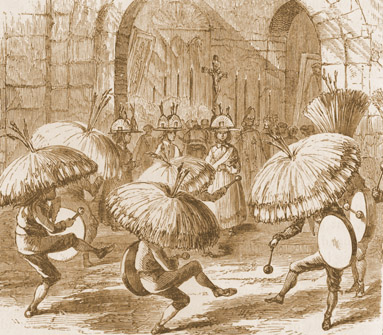
CONTEMPORARY PRACTICES
Festivals and religion are inextricably linked in the
Andean region. The role of music and dance in traditional festivals
and ceremonies continues to this day. Max Peter Baumann, writing in
Cosmología y Música en los Andes, reports as follows:
In the Central Andean Highlands, music,
dance, song, and ritual are closely intertwined. Dance is present in
almost all group-oriented forms of music making. The Quechua term taki
(song) does not contain the idea of language that is sung, but also
rhythmic melody and dance. The three key terms, takiy ("to sing"),
tukay to play, and tusuy ("to dance"), each emphasize
only one aspect of the musical behavior of the whole. These three elements
are complementary to one another and signify the inherent unity of structured
sound, movement, and symbolic expression."
"Musical behavior is always embedded in a particular
context within the ritually and religiously oriented cycle of the
year, Music making and singing are determined by the agricultural
cycle of the two halves of the year, the rainy season (when the seed
is sown and the harvest is brought in) and the dry season (when the
earth is tended and ploughed). The seasons also determine in general
the kinds of musical instruments, melodies and dances that should
be preformed. Numerous festivals are celebrated for the deities belonging
to the earth. During these festivals offerings are made of smoke,
drink and animal sacrifices when the ground is tilled, the seeds are
sown, as the plants grow, and as the people pray for a rich harvest.
Each celebration has its own set of melodies (wirsus or tonadas)
and its own musical instruments. Music and dance are, on the one hand,
expressions of joy and at the same time offerings to honor Father
and Mother Earth (Pachatata and Pachamama)." (Baumann, p. 19)
Music, dance groups and dance costume are an important
part of Andean life today. This author's impression while working in the
Azangaro area (Departamento de Puno, Perú) is that every Indian
was involved and participated. Celebrations were a common sight in the
countryside. Dance in combination with its costumes and music, is the
most impressive aspect of folklore in the Altiplano. From village to village
and from community to community, choreography, music and costume vary.
No two dance groups (eight or more dancers) are quite identical. At regional
festivals the most impressive array of these groups represent their villages,
producing brilliant spectacles of movement, color and music. This aspect
of Andean life draws tourist from the world over to the Altiplano, especially
so in Puno.
Quechua and Aymara peoples today continue to view nature
as very animate. The veneration of Pacha Mama survives. At most major
agricultural occasions, such as the initiation of planting or harvest,
at the inception of a community event such as a hunt and at other activities
of interaction with Pacha Mama, offerings such as drink and coca leaves
are first made. This propitiatory action is often combined with recognition
of Inti. When this author has participated in these offerings they have
been made in the direction of the Sun. Mountains also continue to be
venerated as providers of water and respected for their role in determining
weather. Occasional ritual intoxication is another feature of Andean
culture that the clerics were unsuccessfully in eradicating. The centuries
of Spanish attempts to extricate customs viewed as idolatrous has had
little effect in the countryside or in the most traditional sectors
of modern Andean society. In this author's view this is due to the close
parallels between the metaphors of traditional Andean religion and the
empirical universe.
See Bibliography page for citations.
Other Andes academic papers:
TUPAC
AMARU, THE
LIFE, TIMES, AND EXECUTION OF
THE LAST INCA
EARLY
MONUMENTAL ARCHITECTURE OF THE PERUVIAN COAST
CHAVIN
AND THE ORIGINS OF ANDEAN CIVILIZATION
|